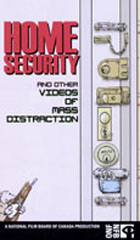
Home Security and other Videos of Mass Distraction 2004
Distributed by National Film Board of Canada, 1123 Broadway, Suite 307, New York, NY 10010; 800-542-2164
Produced by Marcy Page, Robert Forge, René Jodoin, Milan Rychecky, and Thérèse Descary
Directed by Francine Desbiens, Christopher Hinton, Pavel Koustky, Bretislav Pojar, and John Weldon
VHS, color, 30 min.
Sr. High - Adult
Animation, Media Studies, Political Science, Sociology, Film Studies
Date Entered: 03/03/2005
Reviewed by Brian Burns, Hampden-Sydney College, Hampden-Sydney, VirginiaHome Security… is a compilation of five different animated shorts, each dealing with a different sociological dysfunction that is, at least to some extent, caused by outside sources. Inside the clear plastic video case is some thought provoking suggestions for each piece. Although the aim of each of the five films is somewhat obvious, the suggestions go a long way to assist the viewer in focusing on that which the writer and director wanted to get across.
The first vignette is Home Security and it is an exaggerated view of how violence portrayed on television can turn peaceful individuals completely paranoid. The main character is way too concerned about the security of his home after viewing an overabundance of violence on television. The result is a humorous, but sad situation where the danger and violence is inside his home as the rest of the world goes about its merry and peaceful way. Next Watching TV takes things a step further by making a parody of the mayhem existent in the network news and even deeper into the realm of programs and movies that flow freely through the hypnotic portals we refer to as televisions. Does our weekly high dose of 27” diagonal violence transfer itself into our reality? Are we becoming numb and thus, more likely to take up arms against a lamp, dead fish, or shoe (as happens in this animation)?
The last three films move at least somewhat away from the focus of violence. The tyrannical oppression of society is the focal point of E. A new sculpture has been added in the park, but is it an “E” or a “B”? When doctor prescribed eye glasses assist the man with faulty vision see that it is indeed an “E”, everyone rejoices. Enter the sovereign king, who sees a “B”. The same doctor demonstrates the effect eye glasses had on the first gentleman and places them on the king’s face. The king sees an “E”, pins an award on the doctor, crushes the eye glasses, and promptly calls in the military to beat everyone into seeing a “B”. Balablok takes the basic view of how simple differences can cause peoples to war against one another. Using geometric figures (circles vs. squares) as the protagonists, they enter into a conflict and begin the battle only to discover in the end that inside they are quite similar. That is, until the triangles come along. Finally, in Duel, the animators perceive a contradiction between popular reading and culture and more proper or required reading that, in the end, produces perfect cookie-cutter adults. The truth here is twofold in that, some information that is crammed into our heads is important, and that freedom of expression should triumph over censorship.